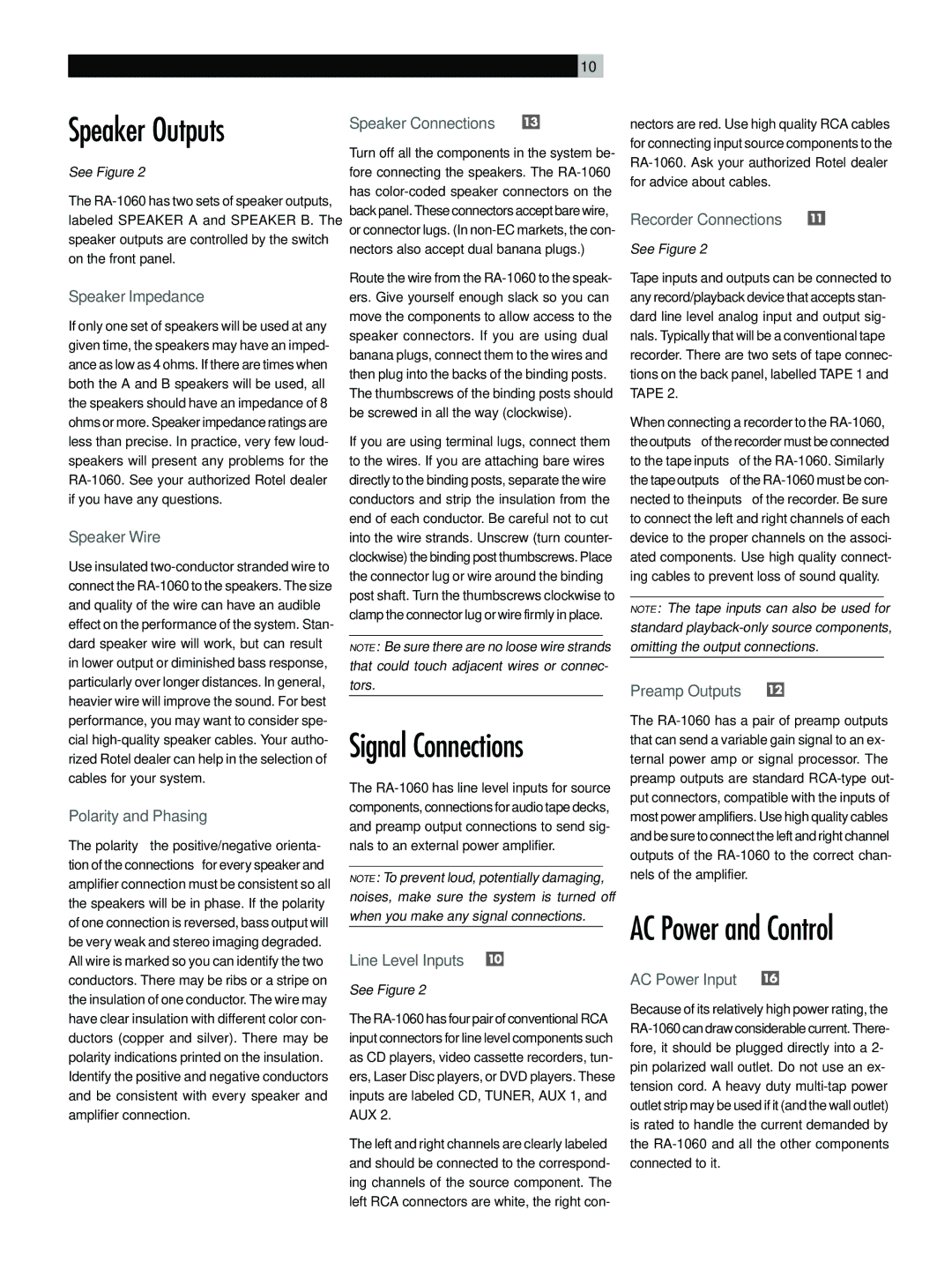RA-1060Stereo Integrated Amplifier
Speaker Outputs
See Figure 2
The RA-1060 has two sets of speaker outputs, labeled SPEAKER A and SPEAKER B. The speaker outputs are controlled by the switch on the front panel.
Speaker Impedance
If only one set of speakers will be used at any given time, the speakers may have an imped- ance as low as 4 ohms. If there are times when both the A and B speakers will be used, all the speakers should have an impedance of 8 ohms or more. Speaker impedance ratings are less than precise. In practice, very few loud- speakers will present any problems for the RA-1060. See your authorized Rotel dealer if you have any questions.
Speaker Wire
Use insulated two-conductor stranded wire to connect the RA-1060 to the speakers. The size and quality of the wire can have an audible effect on the performance of the system. Stan- dard speaker wire will work, but can result in lower output or diminished bass response, particularly over longer distances. In general, heavier wire will improve the sound. For best performance, you may want to consider spe- cial high-quality speaker cables. Your autho- rized Rotel dealer can help in the selection of cables for your system.
Polarity and Phasing
The polarity – the positive/negative orienta- tion of the connections – for every speaker and amplifier connection must be consistent so all the speakers will be in phase. If the polarity of one connection is reversed, bass output will be very weak and stereo imaging degraded. All wire is marked so you can identify the two conductors. There may be ribs or a stripe on the insulation of one conductor. The wire may have clear insulation with different color con- ductors (copper and silver). There may be polarity indications printed on the insulation. Identify the positive and negative conductors and be consistent with every speaker and amplifier connection.
10
Speaker Connections 
Turn off all the components in the system be- fore connecting the speakers. The RA-1060 has color-coded speaker connectors on the back panel. These connectors accept bare wire, or connector lugs. (In non-EC markets, the con- nectors also accept dual banana plugs.)
Route the wire from the RA-1060 to the speak- ers. Give yourself enough slack so you can move the components to allow access to the speaker connectors. If you are using dual banana plugs, connect them to the wires and then plug into the backs of the binding posts. The thumbscrews of the binding posts should be screwed in all the way (clockwise).
If you are using terminal lugs, connect them to the wires. If you are attaching bare wires directly to the binding posts, separate the wire conductors and strip the insulation from the end of each conductor. Be careful not to cut into the wire strands. Unscrew (turn counter- clockwise) the binding post thumbscrews. Place the connector lug or wire around the binding post shaft. Turn the thumbscrews clockwise to clamp the connector lug or wire firmly in place.
NOTE: Be sure there are no loose wire strands that could touch adjacent wires or connec- tors.
Signal Connections
The RA-1060 has line level inputs for source components, connections for audio tape decks, and preamp output connections to send sig- nals to an external power amplifier.
NOTE: To prevent loud, potentially damaging, noises, make sure the system is turned off when you make any signal connections.
Line Level Inputs 
See Figure 2
The RA-1060 has four pair of conventional RCA input connectors for line level components such as CD players, video cassette recorders, tun- ers, Laser Disc players, or DVD players. These inputs are labeled CD, TUNER, AUX 1, and AUX 2.
The left and right channels are clearly labeled and should be connected to the correspond- ing channels of the source component. The left RCA connectors are white, the right con-
nectors are red. Use high quality RCA cables for connecting input source components to the RA-1060. Ask your authorized Rotel dealer for advice about cables.
Recorder Connections 
See Figure 2
Tape inputs and outputs can be connected to any record/playback device that accepts stan- dard line level analog input and output sig- nals. Typically that will be a conventional tape recorder. There are two sets of tape connec- tions on the back panel, labelled TAPE 1 and TAPE 2.
When connecting a recorder to the RA-1060, the outputs of the recorder must be connected to the tape inputs of the RA-1060. Similarly the tape outputs of the RA-1060 must be con- nected to the inputs of the recorder. Be sure to connect the left and right channels of each device to the proper channels on the associ- ated components. Use high quality connect- ing cables to prevent loss of sound quality.
NOTE: The tape inputs can also be used for standard playback-only source components, omitting the output connections.
Preamp Outputs 
The RA-1060 has a pair of preamp outputs that can send a variable gain signal to an ex- ternal power amp or signal processor. The preamp outputs are standard RCA-type out- put connectors, compatible with the inputs of most power amplifiers. Use high quality cables and be sure to connect the left and right channel outputs of the RA-1060 to the correct chan- nels of the amplifier.
AC Power and Control
AC Power Input 
Because of its relatively high power rating, the RA-1060 can draw considerable current. There- fore, it should be plugged directly into a 2- pin polarized wall outlet. Do not use an ex- tension cord. A heavy duty multi-tap power outlet strip may be used if it (and the wall outlet) is rated to handle the current demanded by the RA-1060 and all the other components connected to it.

